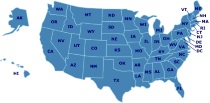Civil War
Things to See & Do in Georgia
Kennesaw Mountain National Battlefield Park
Kennesaw Mountain Battlefield is a 2,888 acre National Battlefield that preserves a Civil War battleground of the Atlanta Campaign. The battle was fought here from June 18, 1864 until July 2, 1864. Shermans army consisted of 100,000 men, 254 guns and 35,000 horses. Johnstons army had 50,000 men and 187 guns. Over 67,000 soldiers were killed, wounded and captured during the Campaign. While walking some of the 17.3 miles of interpretive walking trails you will see historic earthworks, cannon emplacements and various interpretive signs. The 2,888 acre park includes the site of some of the heaviest fighting of the Atlanta Campaign of the Civil War. The park was set aside as an important cultural property dedicated to public inspiration and interpretation of the significant historic events that occurred here.
Chickamauga & Chattanooga National Military Park
Between 1890 and 1899 the Congress of the United States authorized the establishment of the first four national military parks: Chickamauga and Chattanooga, Shiloh, Gettysburg, and Vicksburg. The first and largest of these, and the one upon which the establishment and development of most other national military and historical parks was based, was Chickamauga and Chattanooga. It owes its existence largely to the efforts of General H.V. Boynton and Ferdinand Van Derveer, both veterans of the Army of the Cumberland, who saw the need for a national park to preserve and commemorate these battlefields during a visit to the area in 1888. The Park is located at Fort Oglethorpe, Georgia.
Fort Pulaski National Monument
The defining events of Fort Pulaski occurred during the American Civil War. In April of 1862, Union troops directed rifled cannon fire at the fort breaching the southeast angle. Immediately after capturing the fort, Union Major General David Hunter, an ardent abolitionist, ordered the release of area slaves. Many were recruited into the Union army comprising the First South Carolina Colored Regiment. The park includes scenic marsh and uplands that support a variety of animal life characteristic of southern barrier islands. White-tailed deer, alligators, and raccoons as well as resident and migratory birds grace the landscape. Spanish moss drapes from yaupon holly bushes and vegetation includes cabbage palms, various wetland grasses, and a variety of temperate hardwood and pine trees. Fort Pulaski is located about fifteen miles east of Savannah.
Andersonville National Historic Site
Andersonville, or Camp Sumter as it was officially known, was one of the largest of many Confederate military prisons established during the Civil War. Today, Andersonville National Historic Site is the only park in the National Park System to serve as a memorial to all American prisoners of war throughout the nation's history. The 515-acre park consists of the historic prison site and the National Cemetery.
Atlanta History Center
Explore award-winning exhibitions in the Atlanta History Museum, a two-story facility with 30,000 square feet of exhibition space, an 118-seat theater, a museum shop, The Coca-Cola Cafe, and classrooms. Collection includes objects dating from the early 19th century to the present. At its core are those items that refer to the history of Atlanta and its environs, but the collection also includes items that refer to the history of Georgia, the South and the nation. The collection also includes historic homes and gardens.
Featured Resources
As an Amazon Associate, we earn from qualifying purchases. We get commissions for purchases made through links on this site.
A Twaddle-Free Education: An Introduction to Charlotte Mason's Timeless Educational Ideas
Are you disappointed with dumbed-down reading material (“twaddle”) written for children? Do you wish for your children to feast their hearts and minds on noble ideas, fine art, and great literature? Are you hoping your children gain an appreciation of nature and a deep understanding of natural sciences? Most importantly, do you want your children to develop a lifetime love of learning? If you answered “yes,” you may discover a Charlotte Mason-inspired twaddle-free education is just what you’ve b...
Children at Play : Using Waldorf Principles to Foster Childhood Development
Children at Play is an insightful exploration into the world of children's play and its tremendous significance in the shaping of each child's humanity. A mother and proponent of Rudolf Steiner's Waldorf system of education, author Heidi Britz-Crecelius offers practical suggestions and an up-to-date list of resources for today's families.
The Unschooling Handbook : How to Use the Whole World As Your Child's Classroom
Unschooling, a homeschooling method based on the belief that kids learn best when allowed to pursue their natural curiosities and interests, is practiced by 10 to 15 percent of the estimated 1.5 million homeschoolers in the United States. There is no curriculum or master plan for allowing children to decide when, what, and how they will learn, but veteran homeschooler Mary Griffith comes as close as you can get in this slim manual. Written in a conversational, salon-style manner, The Unschooling...
Serving Homeschooled Teens and Their Parents (Libraries Unlimited Professional Guides for Young Adult Librarians Series)
This guide for librarians addresses the needs of homeschooled teens and how a library can meet those needs. Includes ideas like developing a homeschool resource and book collection to creating special homeschool programs. While this book was written for library staff, it is also an insightful guide into how homeschoolers and libraries can work together.
Drawn Into the Heart of Reading
Drawn Into the Heart of Reading was developed for use with students of multiple ages at the same time, perfect for the homeschooling family. It is designed for use as an entire reading program or as a supplement to an existing program for students in grades 2-8.




